
Interpretation:
The reason to seal the capillary tube from the open end for the melting point determination for a compound that sublimes should be stated.
Concept introduction:
For a crystalline substance, the temperature at which the substance changes from solid phase to liquid phase is referred to as melting point. Melting point is directly associated with the presence of intermolecular forces like hydrogen bonding, dipole-dipole interactions. High molecular symmetry, large surface area, polarity is related to high melting temperature.
A pure compound melt at a narrow range and compounds with impurities have broad melting temperature. Melting points are obtained by filling the organic compound into the capillary tube with one sealed end.
Sublimation is a process where a gaseous phase is obtained directly from the solid phase.
Want to see the full answer?
Check out a sample textbook solution
Chapter 14 Solutions
Laboratory Techniques in Organic Chemistry
- Which of the melting point capillaries in the picture below is filled to the proper level for taking a melting point on a MelTemp melting point apparatus? OB OC OA 12 01489 5arrow_forwardComplete the following statement with the appropriate terms: "In general, the technique used in this experiment can be used to separate the compounds in a mixture using intermolecular interactions between a solid and a liquid The types and strengths of interactions between each compound and each phase determine how quickly a compound travels: compounds that interact better with the travel quickly, while compounds that stationary phase travel slowly." mobile phase interact better with thearrow_forwardUsing Dalton’s Law of Partial Pressure, explain how steam distillation is a useful technique for heat sensitive substances such as essential oils.arrow_forward
- Explain and sketch the Born-Mayer equation to determine the crystallization energy of NaCl and MgCl2arrow_forwardConsider this information regarding two compounds. Thallium azide: yellow crystalline solid; melting point = 330 C; slightly soluble in water, more soluble in hot water; insoluble in ethanol or diethyl ether. Camphene: colorless, cubic crystals; melting point = 51 C; boiling point = 159 C; insoluble in water; moderately soluble in ethanol; soluble in diethyl ether. (a) Is camphene an ionic or molecular compound? Explain your answer. (b) Is thallium azide an ionic or molecular compound? Explain your answer.arrow_forwardExplain how vacancies are introduced in a solid NaCl crystal when divalentcations are added to it.arrow_forward
- Aromatic compound naphthalene melts sharply at 79–81 °C. The melting range will be significantly depressed when very small amounts of impurities are present. Investigate the structure of naphthalene and propose an explanation of why very minor impurities have a very significantly disrupt formation of crystals.arrow_forwardexplain how mixed melting point determination can be used to identify a solid compound.arrow_forwardWhy is it best to cool a solution slowly as a solid crystallizes? impurities are more likely to crystallize as well when done quickly the solid obtained will have a higher purity when done quickly no solid will form when done quickly the solvent could start to boil again when done quicklyarrow_forward
- Give the advantages of using steam distillation in the recovery of an inorganic liquid from a mixture.arrow_forward3. A student is trying to identify an unknown solid based on its melting point. She noted that the compound began to melt at 172°C and finished melting at 177°C. Knowing it is possible for there to be impurities in the sample, is this compound more likely to be camphor or hydroquinone. Explain your reasoning. 4. A young chemist has synthesized what he believed to be acetaminophen. He measured the melting point of this newly formed compound to be 163-178°C. If the literature value for the melting point of acetaminophen = 169-170.5°C, would the young chemist be wise to consume this product for headache relief? Why or why not?arrow_forwardSketch the phase diagram of the NH3/N2H4 given that these two compounds do not react with each other. NH3 freezes at -78.000C while N2H4 freezes 2.000C. The eutectic is formed when the mole fraction of N2H4 is 0.07 and the eutectic melts at -80.000C. Label all the regions in the phase diagram and indicate which species are present and in which physical state.arrow_forward
 Principles of Modern ChemistryChemistryISBN:9781305079113Author:David W. Oxtoby, H. Pat Gillis, Laurie J. ButlerPublisher:Cengage Learning
Principles of Modern ChemistryChemistryISBN:9781305079113Author:David W. Oxtoby, H. Pat Gillis, Laurie J. ButlerPublisher:Cengage Learning Chemistry: The Molecular ScienceChemistryISBN:9781285199047Author:John W. Moore, Conrad L. StanitskiPublisher:Cengage Learning
Chemistry: The Molecular ScienceChemistryISBN:9781285199047Author:John W. Moore, Conrad L. StanitskiPublisher:Cengage Learning

